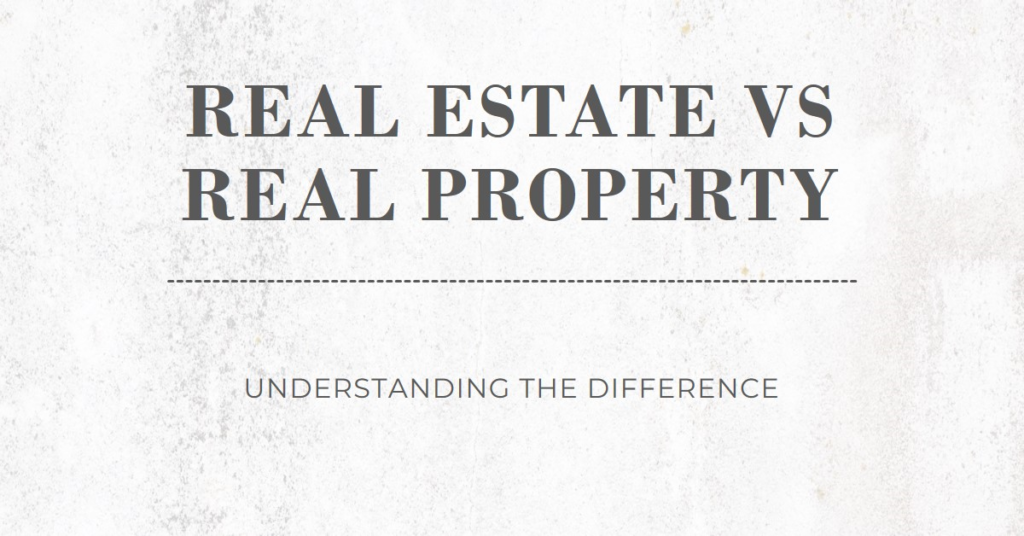
Table of Contents
Introduction:
In the labyrinth of real estate jargon, the terms “real estate” and “real property” often interchangeably used, leaving many bewildered about their actual distinctions. While seemingly synonymous, these terms carry nuanced disparities that hold significant weight in the realm of property ownership and transactions. Understanding these disparities is pivotal for anyone delving into the world of real estate. In this comprehensive guide, we delve deep into the dichotomy between real estate and real property, shedding light on their disparities and implications.
Real Estate:
Beyond the Brick and Mortar Real estate, in its essence, encapsulates tangible entities such as land, buildings, and other fixtures attached to the land. It encompasses the physical, tangible aspects of property ownership, ranging from residential homes to commercial complexes. When individuals discuss real estate, they often refer to the tangible structures and land parcels that constitute the physical landscape of properties.
Real Property:
Unraveling the Legal Tapestry Contrary to the concrete nature of real estate, real property delves into the legal realm, encompassing not only the tangible assets but also the bundle of legal rights associated with them. Real property extends beyond the physical components to include the legal interests, rights, and ownership entitlements associated with land and its improvements. These legal rights dictate how individuals can use, transfer, or restrict access to the property.
Legal Distinctions:
Bridging the Gap The disparity between real estate and real property lies in their legal ramifications and conceptual frameworks. Real estate primarily concerns the physical attributes of properties, while real property delves into the legal aspects of ownership and rights. Real estate serves as the tangible manifestation of real property rights, embodying the legal entitlements bestowed upon property owners. Understanding this dichotomy is crucial for navigating the intricacies of property transactions and legal proceedings.
Ownership Rights:
The Bedrock of Real Property At the core of real property lies the bundle of ownership rights that delineate the extent of control and dominion a property owner holds over their assets. These rights, often referred to as “sticks in the bundle,” encompass a spectrum of privileges, including the right to possess, use, transfer, encumber, and exclude others from the property. Real property rights serve as the cornerstone of property law, governing the interactions and transactions involving land and its improvements.
Transferability:
Crossing Legal Thresholds One of the fundamental distinctions between real estate and real property lies in their transferability. While real estate transactions involve the transfer of tangible assets, real property transactions encompass the conveyance of legal interests and rights associated with the property. Transferring real property requires adherence to legal formalities, such as deeds, contracts, and title transfers, to ensure the lawful transfer of ownership rights.


Legal Formalities:
Navigating the Terrain Navigating the legal terrain of real property transactions entails adhering to a myriad of formalities and procedures aimed at safeguarding the rights and interests of all parties involved. From drafting meticulous contracts to conducting thorough title searches, each step in the transaction process is imbued with legal significance. Failure to comply with these formalities can lead to legal disputes, encumbrances, or clouded titles, jeopardizing the integrity of the transaction.
Tax Implications:
Deciphering Fiscal Ramifications The disparity between real estate and real property extends to their tax implications, with each carrying distinct fiscal ramifications for property owners. Real estate taxes are levied on the tangible assets and structures comprising the property, such as land and buildings. In contrast, real property taxes encompass the broader spectrum of ownership rights and interests associated with the property, including easements, air rights, and mineral rights. Understanding these tax distinctions is essential for property owners seeking to optimize their fiscal strategies and mitigate tax liabilities.
Future Trends:
Paving the Path Ahead As the landscape of real estate continues to evolve, discerning the disparities between real estate and real property becomes increasingly paramount. From blockchain technology revolutionizing property transactions to sustainable development reshaping urban landscapes, the future holds a myriad of opportunities and challenges for property stakeholders. By grasping the nuances of real estate and real property, individuals can navigate this dynamic terrain with clarity and confidence, unlocking new possibilities for growth and innovation.
Conclusion:
Charting a Course Forward In the intricate tapestry of real estate terminology, the distinction between real estate and real property serves as a guiding light for property stakeholders navigating legal, financial, and transactional landscapes. While real estate encompasses the tangible assets comprising properties, real property delves into the legal rights and interests underpinning ownership. By comprehending these disparities and their implications, individuals can navigate the complexities of property ownership and transactions with acumen and assurance, charting a course toward prosperity and success in the ever-evolving realm of real estate.


